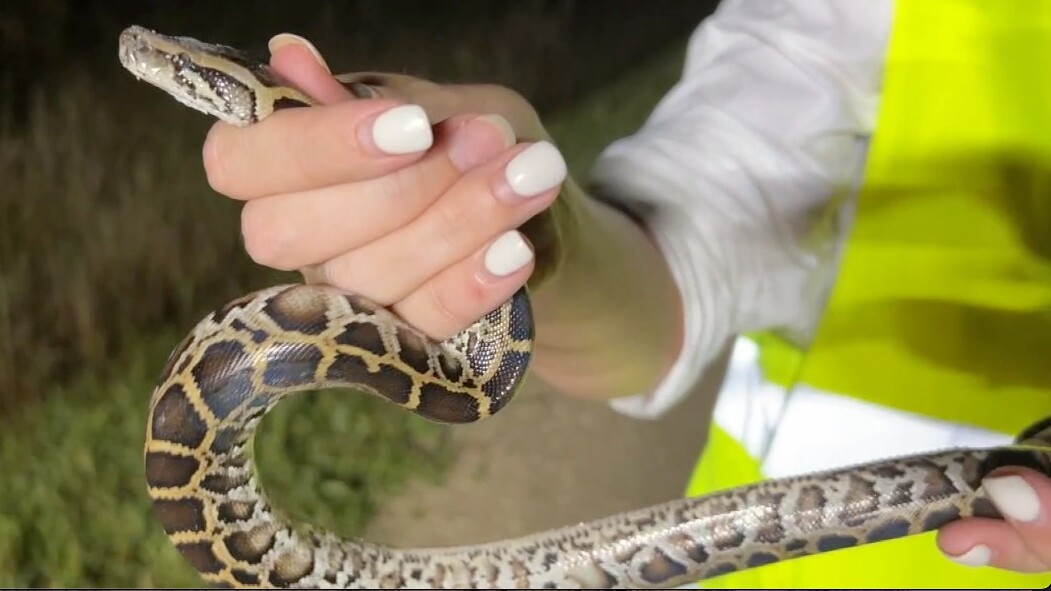WEST PALM BEACH, Fla. — Invasive Burmese pythons are now more prevalent than some native species in the Florida Everglades, and stopping their rampant spread is still no easy task.
The state's annual Python Challenge kicked off and wrapped up this month for the 10th year. State officials are still tallying up the data to see how many pythons were removed and who captured the largest snake to win a cash prize.
Hundreds of hunters from across the country participate during the 10-day challenge. But a smaller, dedicated group of Florida-based hunters make this a year-round commitment, dedicated to protecting the Everglades.
"Once it's go-time, it's not getting away from me, I'll tell you that. It will not get away from me. I will figure out to get it every time," Amy Siewe said.

She's the self-dubbed "Python Huntress" who said she has captured more than 500 pythons in her four years of hunting full-time. She's a former realtor who gave up a comfortable job for something that hones her biggest passion.
"When we see those big ones, you know it's going to be a challenge. It's so exciting for me," Siewe said. "I will never go back to a normal 9 to 5 [job]."
She's been hunting long enough to know exactly what to look for and where to hunt for the best chance of removing the predators. Wildlife experts said they're known to eat more than 70 different species of other reptiles, mammals and birds.
Siewe said she's noticed she no longer sees marsh rabbits like she used to. Pythons have taken their place.
No one knows for sure how many pythons are sprawling through the Everglades but estimates exceed 300,000. Some captured pythons have been found with dozens of eggs, showing how removing even one python has the potential to save hundreds of native animals.

"We found a python that had a doe and two fawns in her at the same time," Siewe said. "The problem is our native animals don't recognize pythons as a threat because they're not from here, so I think that's one of the reasons everything is so easy to eat here."
Siewe brought WPTV reporter Meghan McRoberts on a hunt, covering about 100 miles in six hours. That hunt showed exactly how pythons have managed to cover so much ground in the roughly 40 years since experts believe they invaded the Everglades after pet pythons were released into the wild. They're hard to find, and many are likely in remote areas of the Everglades that are hard to access.
Other hunters passed Siewe on the hunt with WPTV, also looking to put a dent in the python invasion.
"Our python community is incredibly competitive, but there's also a camaraderie there too because we're all working for the same goal," Siewe said. "We're trying to get rid of these pythons."
Fewer than 20,000 pythons have been removed from the Everglades in 20 years, according to the Florida Fish and Wildlife Conservation Commission. That's because hunting one by one is still the best means of removal. Siewe said research is underway to try to find a better way to remove more pythons at once without putting the ecosystem at risk.

The night that WPTV joined the hunt, the weather dropped to cooler temps with rain in the mix. That made for a night without a single capture.
WPTV went on a second hunt about a week later with Donna Kalil, a veteran hunter.
One hour into the hunt, they caught a hatchling, likely only a week old.
"That's a little guy now, but this guy could turn out to be 18 feet if we weren't out here getting him out of the Everglades," Kalil said.
Kalil is permitted by the state to capture pythons. The South Florida Water Management District and FWC issue 50 permits each to hunters who can earn money by hunting at an hourly rate or by the size of the pythons they capture.

"I'm trying to save the Everglades," Kalil said. "I'm trying to save the animals that I love, the native animals that I grew up seeing out here."
During both hunts, WPTV still saw native animals on the move, such as deer, birds, rats, hogs and native snakes.
"We still have wildlife left," Siewe said. "We see opossums. We see deer, bobcats, panthers, all kinds of native snakes. It's good to know we still have some left."
That's what keeps them on the prowl, even knowing the odds of eradicating pythons are very much against them.
"Every single python I take out is saving the lives of hundreds of our native animals," Siewe said. "When I concentrate on that, it makes it all worth it."
The hunters follow strict guidelines for humanely killing the pythons.
Participants removed 231 invasive Burmese pythons during the 10-day competition in 2022.




